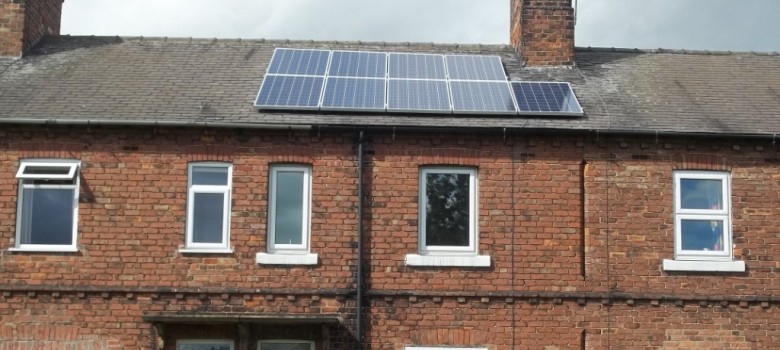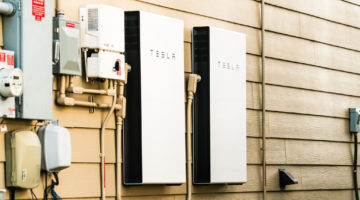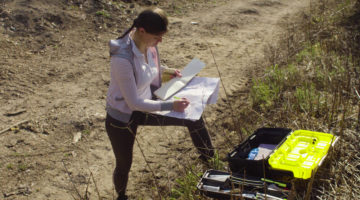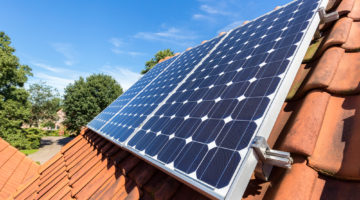
UPDATE: The Feed-In Tariff is now closed for new applications. To find out about the new scheme designed to replace it, click here.
Well over 500,000 properties in the UK now have solar panels installed on their roofs – this equates to approximately 2% of the 28,000,000 homes here in the UK.
There is therefore a reasonable chance that if you are in the market to buy a new property you will come across properties that already have solar panels installed. In this article we want to look at some of the questions you need to ask yourself before buying a house with an existing solar system.
Question 1 – how big is the solar system?
Firstly how big is the solar system – this can be calculated very easily by counting the number of panels. On the whole most solar panels are 250 watts each so if you had 4 panels you would have a 1kW (1000 watts) system and if there were 14 panels, then you would have a 3.5kW system (3500 watts).
This should give you an idea of how much completely free, renewable electricity you are going to produce from your new solar system and therefore how much you can use in the house.
If you count the panels and multiply the size by 90% – this will give you a very approximate number of kWh you will produce. A kWh is a unit of electricity – this is what most of us buy from the grid and depending on your energy supplier this could cost anywhere between 10-15 pence. Take for example a system with 10 solar panels on the roof:
- 10 panels x 250 watts each = 2500watts (also known as 2.5kW).
- 2500 watts x 90% = 2250 kWh
- 2250 kWh x 10p = £225 worth of electricity is being produced by your solar panels
Now you just need to find a way to use it!
Question 2 – who installed the solar panels?
Ask the existing homeowner who installed the solar panels – this is important for a few reasons, firstly you can find out if they were MCS approved. The lack of MCS approval isn’t necessarily a deal breaker but for reasons we shall see shortly it can make the solar system considerably more attractive! The Microgeneration Certification Scheme (MCS) is a nationally recognised quality assurance scheme, supported by the Department of Energy and Climate Change. The Government are keen for all installers of solar PV systems to be signed up the MCS register, however there are some installers out there who have shunned the whole MCS process to allow them to install solar systems for cheaper.
What does MCS approval show? Well it should provide a certain level of comfort that the installer did the job well – to certain industry standards. Likewise the MCS certificate also shows that the panels that have been installed have gone through rigorous testing that satisfy European and International standards.
The real kicker about inheriting an MCS approved solar panel system is that you should be able to benefit from the feed-in tariff. This is a payment for producing electricity from the solar system. The payments will depend when the system was installed so the next question to ask is exactly that.
Question 3 – When was the system installed?
Not only will the age of the system dictate the Feed-in tariff payments you can expect to receive it will also give you a rough idea of when you are going to need to replace the inverter – normally the whole system should be good for 20-25 years, with the exception of this component. The reason the inverter only last this length of time is because they need to deal with kilowatts of power and high input DC voltages, so they need high power transistors and electrolytic capacitors – these components unfortunately just don’t last as long.
The cost of replacing an inverter on a 3.5kW system is approximately £800 – so if the system was installed 5 years ago – you need to budget for this payment within the next few years.
So back to the feed-in tariff – what will you receive? Well the table below shows how the Feed-in tariff has changed since its launch in 2011. On the left hand side of the table are the digression dates – these are the dates that the effective FIT payment was reduced from. For example if a system was installed and registered on the 10th July 2013, the payment would be 14.90 pence per kWh produced.
| Digression Date for Solar PV | Feed-in tariff rate (pence / kWh) |
|---|---|
| 01-Aug-11 | 43.30 |
| 01-Apr-12 | 21.00 |
| 01-Aug-12 | 16.00 |
| 01-Nov-12 | 15.44 |
| 01-Jul-13 | 14.90 |
| 01-Apr-14 | 14.38 |
| 01-Jan-15 | 13.88 |
| 01-Apr-15 | 13.39 |
| 01-Jul-15 | 12.92 |
| 01-Oct-15 | 12.47 |
The feed-in tariff is paid over 20 years, however if you were lucky enough to get in before this date it was paid over 25 years, so the returns will be even larger.
In order to calculate your expected feed-in tariff payments, you take the size of the system (see Question 1 for how to do this) – multiply this by 90% and then multiply it by the relevant rate from the table above.
For example – a 3.5kW system installed on 10th July 2013
- 3500 watts x 90% = 3150 kWh (you can expect to produce each year)
- FIT payment = 14.90 pence per kWh (from the table above)
- 3150 kWh x 14.90 pence = £469.35 annual payment
- This is tax free and goes up annually with RPI
That means that if you were to buy the house today, you would therefore receive a total income of approximately £8000 without taking into account RPI increases. This is on top of the energy savings that are illustrated at the end of question 1 – so including these you could expect a total return of over £13,000.
 Question 4 – Were the panels installed as part of a rent a roof scheme?
Question 4 – Were the panels installed as part of a rent a roof scheme?
Some people installed solar panels on their home as part of a rent a roof scheme – this is where a third party will pay for the solar system to be installed, however the homeowner needs to sign over all the feed-in tariff payments to this third party.
Mortgage companies don’t like these schemes! The third parties required a lease to be signed, which gave them access to your roof for 20-25 years. These leases are binding on any future buyers, so as the new potential homeowner you will need to everything set out in the lease. Mortgage lenders will be concerned if installations come with a requirement to cover maintenance costs or grant onerous access rights to the provider so may not be happy to lend against such a property.
Also since the panels are in place and can’t be removed under the terms of the lease, it means that if you have big plans to put on a roof extension or a similar development, you will need to wait until the lease lapses!
Our final thoughts on buying a house with solar PV
As a buyer certainly shouldn’t be put off buying a property with solar panels, however if the panels lack the MCS accreditation or were installed as part of a rent a roof scheme we would be very cautious. We would certainly seek legal advise if this is the case just to see where you stand. Having said that – it should certainly put you in the driving seat in terms of negotiations over the price. If however the owners own the property outright, since the panels will be a cash generating asset, you can expect to pay a small premium on the house price as a result.
Installing Solar PV
Are you thinking about installing a solar PV system at home? We have scoured the country for the best tradespeople, so that we can make sure we only recommend those we really trust.
If you would like us to find you a local installer to help install a solar PV system in your home, just fill in the form below and we will be in touch shortly!













I would like to muscle in before the Feed in Tariff is reduced at the end of this year. I need to move quick so does anyone know where I can buy Solar Panels and the mounting equipment?? need to move on this fast.
Hi Ac you need to actually have the panels installed by an MCS accredited installer. Once installed and registered on the approved database will you be in a position to successfully claim the generation and export feed-in tariffs (FiTs). Hope this helps
Hi,
Great article, very interesting. One question though, you said “That means that if you were to buy the house today, you would therefore receive a total income of approximately £8000 without taking into account RPI increases. This is on top of the energy savings that are illustrated at the end of question 1 – so including these you could expect a total return of over £13,000.”
I think I am misunderstanding this, but this comment seems to suggest that a) I get paid for every unit of electricity I generate and then b) I also then get to use those units of electricity for free?
I thought the whole point of a FIT was that you get paid for generating elec and putting it back onto the grid?
Hi, that is correct. There are two parts of the Feed in tariff.
1. Generation tariff – this is a payment for every unit of electricity produced regardless of whether it is used in the house or sold back to the grid. This is currently set at 12.47p for every kWh generated from the solar system.
2. The export tariff – this is paid for every unit of electricity exported back to the grid (4.85p / kWh).
BUT since you can use the electricity produced from the solar panels in your home, you don’t need to buy these units from the grid. The average price of electricity is about 12.5 pence per kWh, so this is a saving for every unit you use (and don’t have to import from the grid).
Since the export tariff is only 4.85p/kWh, and the price of energy is 12.5 p/kWh when bought from the grid, it is actually better to maximise the amount of electricity you use in the home – and therefore export as little as possible. There are solar Optimisers that do just this – they stop electricity being exported – instead it is diverted.
As a final point, when solar panels are fitted, it is very unusual for a company to install an export meter so the energy companies (which pay the FIT) have no way of knowing what is actually exported. Therefore the energy company calculates this by assuming you export 50% of what is generated. This 50% figure is paid regardless of whether in reality you export zero electricity or you export 50%, so it makes even more sense to use the electricity you produce from your solar panels!
My Husband and I bought our house in 2012 and it had a 4kW solar system installed on the roof. It is not something we would normally have looked at but actually we are thrilled with them now we understand how the gov. tariffs work. Basically we get paid every year for the next 21 years approximately £1500 an then we get the free electricity. It did mean we had to pay a small premuim for the property. Again we didn’t understand why, but our estate agent was actually very knowledgable and talked us through all the payments we would likely receive. I am not sure if we bought a new house we would get solar panels again becuase I think the gov. tariff has really dropped so not sure it would be worth it, but I certainly wouldn’t be put off buying a house with solar panels again!
Has the government introduced a scheme to help existing solar panel owners,where the installers are no longer trading?
My mother had free solar panels fitted on her roof she doesn’t seem to have any paperwork and has forgotten the company who fitted them how can she find out who fitted them?
Hi, you should speak the MCS association – they should have a register. The reason installers could offer free solar panels in the first place was that they would receive the FIT payments rather than the household. In order to get the FIT payments, the install must have been carried out by a MCS certified installer – hence the MCS accreditation body should have all the details of the install and the installer who put the panels on the roof. Hope that helps!
Can the free solar panels on my decieced mums house be removed as we are having problems selling it.
Hi pammysquirrel, I am very sorry to hear this. Unfortunately there is not a whole lot you can do about this – you really only have two options, firstly find a buyer who is willing to take on the solar lease, or you will need to buy out the lease by paying off the company who put the panels on the roof. Obviously the second is going to be expensive, so the first option would certainly be preferable.
So what happens when you buy a house with solar panels already fitted? Does the existing FIT plan come with the property and is then transferred to the new owner?
Yes it does, provided the meter ownership is registered to the new owner. Apologies, if it wasn’t clearer in the article.
We are currently selling our house with leasehold panels. We have all the relevant paperwork but despite this have just got to exchanging contracts and our buyer has pulled out. It seems as though they were ‘put off’ by their solicitor. The question here is how do we proceed without getting to this stage again and the buyers pulling out. Should we provide all the pertinent detail to the agent and then have an estate agent who puts this information to a potential buyer ‘up front’ or would it be wiser to pay the extortionate amount required by the installer and own them outright. It now stands at £27,500 as we have only had them for 5 years.
What about selling a house with free solar panels?
Hi Liz, we are seeing a few people struggling to sell properties that have free solar panels. The problem is that some mortgage lenders are funny providing mortgages to potential buyers that want to buy these properties – basically it means you either need a cash buyer or you need to ‘buy out’ your free solar contract.
My mother in law has a house which we bought out right the solar panels we put on it. Are there any more informed estate agents that will be helpful when trying to sell this property. Some estate agents don’t know how to value the property to take into account the income she receives from them which is enough to pay for all of her bills associated with running the house including window cleaner!
Hi Ann,
It is a tricky one – as someone people are nervous about taking on the potential future costs of such a system – for example new inverters and so forth. I think as more and more properties swap hands that have solar panels in place, then the estate agents will get better and better and valuing it. My sisters property for example has both a ground source heat pump and solar (they were on oil originally), and they receive a payment of approximately £1000 per quarter for the GSHP via the RHI and £280 per quarter with the FIT payments – she has just put her property on the market and the estate agents don’t know where to start!
Having probelms with a solar lease? Join the petition… surely there is enough of us to have our voices heard.https://www.change.org/p/theresa-may-mp-demand-a-review-and-changes-to-solar-lease-agreements
How can I find out if the property I am buying has an mcs certification, as the seller has no paperwork
Hi Gina, I suggest calling MCS directly – they should be able to advice if the install was done under the scheme as they have a database of installs.
I’ve bought a hous with solar panels installed and the seller agreed to pay all charges outstanding (which he has). However, further investigation finds he never registered them so was never in any in feed tariff. Why he didn’t only he will know, my question is apart from the small amount of free energy I get, is there anything else at all I can do with them? Do they have any sell on worth?
I am looking at a house which has solar panels installed. The vendor advised me that they wanted to take the solar panels with them when they move and I am concerned about this a) for the potential damage it could cause and b) even if there is no damage to the roof, there could be discolouration to the roof. Have you any advice/pictures of houses where panels have been removed from the roof?
im buying house with solar panelling do I have keep same energy company or can I use whom I’m already with..mrs ball
We are bringing asked for the maintenance contract details from the mortgage supplier on a house we have made an offer for. The purchase is a repossession and the company who installed them is no longer in business, how can I find out ownership/ maintenance .
I have a house with solar panels that I bought when people were saying you would never get your investment back. They paid for themselves after 6.5 years and so all the money I get now £2000 p.a. is free. Would I really have a hard time trying to persuade buyers that taking the £10,000 for free over five years would be a bad thing? Would they really make a reduced offer because they did not want the extra income for nothing.
We have just moved into a new house with 3 yr old solar panels that have been paid outright for. How do we claim back the money at the end of each yr
I am buying a house that has solar panels installed about 20 years ago. They have caused damage to the roof that now has to be redone. The sellers can’t find the contract. I’m also keen to convert the loft of the property. How can I find what type of contract is in place?